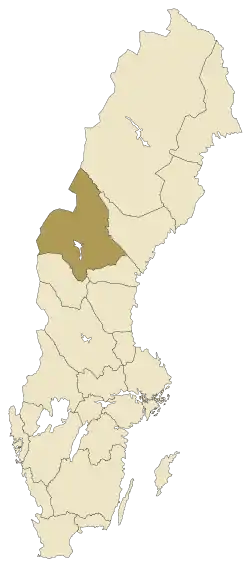Jämtland dialects
Jämtland dialects (jamska [ˈjamskɐ]; Swedish: jämtska, jämtmål) constitute a group of closely related dialects spoken in the Swedish province of Jämtland. They are commonly used in the entire region, with the exception of Frostviken in the northernmost part of the province, where the local dialect is of trøndersk origin, due to its later settlement from Norway. In the eastern part of Jämtland the dialects are transitional to those of Ångermanland. The dialect group is commonly regarded and treated as a single entity. Some people consider it a language separate from Swedish.
| Jämtlandic | |
|---|---|
| jamska | |
| Region | Jämtland |
Indo-European
| |
| Language codes | |
| ISO 639-3 | None (mis) |
jmk (retired ISO code) | |
| Glottolog | jamt1238 |
 Jämtland in northern Sweden | |
Jamtlandic shares many characteristics with both Trøndersk—the dialect spoken in Trøndelag, Norway—and with the dialects spoken along the coast of Norrland, Sweden. Due to this ambiguous position, there has been a debate since the early 20th century whether Jamtlandic belongs to the West Norse or the East Norse language group. Jamtlandic cannot be uniquely defined belonging to either of these groups. Prior to, and around, the time of the dissolution of the Swedish–Norwegian union, Jamtlandic was undisputedly considered a dialect of Norwegian. See, e.g., p. 112 in part one of Adolf Noreen's Vårt språk (translated from Swedish):
- The Westnorthern Swedish ("Norwegian-Swedish"), originally Norwegian dialects in Särna and Idre (the northwesternmost Dalarna), Härjedalen and Jämtland (where, though, the language east of Östersund eventually passes into Medelpadian or Ångermanlandic).[2]
Name
The local name for the dialects is jamska, whose literal equivalent in English would be Jamtish or Jämtish. There is, however, no common term for the dialects in English, and academic sources call them by various names, such as jamska, jämtska, Jämtish dialect, Jämtlandic dialect, Jämtland dialects or dialects of Jämtland.
The endonym jamska is technically a definite form; the indefinite form jaamsk/jamske is rarely used.
Language
Since the early 20th century, whether Jamtlandic is a dialect or a language has been hotly debated. Proponents of Jamtlandic as a language point to the differences in vocabulary and pronunciation. A great percentage of the Jamtish speakers recognise Jamtish as a language rather than a Swedish dialect. There have been efforts to make the Swedish government recognise it as a minority language just as Yiddish and Sami. One of the more prominent people that have been active in the effort to make Jamtish a recognised language is Bo Oscarsson. Oscarsson has written books about the Jamtish language/dialect and even compiled dictionaries.
History
According to the sagas, the region called Jämtland was originally settled by fugitives from Trøndelag after Harald Fairhair united Norway in the 9th century. It became part of Norway during the reign of Haakon I in the 10th century and remained part of Norway until the 17th century. At that point it became part of Sweden. The history of the region accounts for many of the dialect's features.[3]
It is difficult to the trace the history of Jamtlandic dialects because written sources only exist from the early 18th century, if not including the early 11th century Frösö runestone or the 14th century legal documents which can not be confirmed to have been written in Old Jamtlandic, the assumed distinct Jamtlandic dialect of Old West Norse.
Orthography
There have been attempts to standardize the orthography of Jamtlandic. The attempt that has been the most popular is Vägledning för stavning av jamska (1994 and 1995) which is the work of the committee Akademien för jamska consisting of Bodil Bergner, Berta Magnusson and Bo Oscarsson. The most prominent application of this orthography has been to prepare translations of parts of the Bible into Jamtlandic resulting in the book Nagur Bibelteksta på jamska. An excerpt:
Genesis 1:26–27:
- 26Å Gud saa: ’Lätt oss gjära når mänish, nager som e lik oss. Å dom ske rå öve fishn derri havan å över foglan pyne himmela, å öve tamdjura öve heile jola, å öve all de djur som kravl å rör se på jorn.´
- 27Å Gud skapa mänishan å gjool som n avbild ta se själv. Te kær å kviin skapa n dom.
The book does not fully follow Vägledning för stavning av jamska. For example, using Vägledning för stavning av jamska one would spell gjæra v. 'do; make', not "gjära". Another spelling convention in Nagur Bibelteksta på jamska is the use of the digraph "sh", in e.g. "mänish" n. 'human being' and "fishn" n. 'the fish', with the same pronunciation as English 'sh' in 'shoe'. Properly using Vägledning för stavning av jamska, this would be spelled sch; see § 26 in the external link below. Jamtlandic uses the letters of the Swedish alphabet, with the addition of æ and ô. The letters c, q, w, x, and z are not used in the Jamtlandic alphabet.
References
- Dalen, Arnold (2005). Jemtsk og trøndersk – to nære slektningar Archived 18 March 2007 at the Wayback Machine. Språkrådet, Norway. (In Norwegian). Retrieved 13 November 2007.
- Noreen, Adolf (1908). Vårt språk.
- Gjerset, Knut (1915). History of the Norwegian People, Volumes I & II. The MacMillan Company.
- Dä glöm fäll int jamska, published by Margareta Persson (red.), 1986
- Reinhammar, Vidar (January 2005). Hammerdalsmålet. http://www.ssp.nu/nyheter/gustavadolf/folklivsbygd/hammerdal.htm: Swedish Science Press. ISBN 91-85352-59-4.
External links
- Code for Jamtlandic (jmk)
- Jamska - the dictionary project
- Jemtsk og trøndersk – to nære slektningar by Arnold Dalen
- Vägledning för stavning av jamska by Akademien för jamska
- Publisher's webpage about Nagur Bibelteksta på jamska